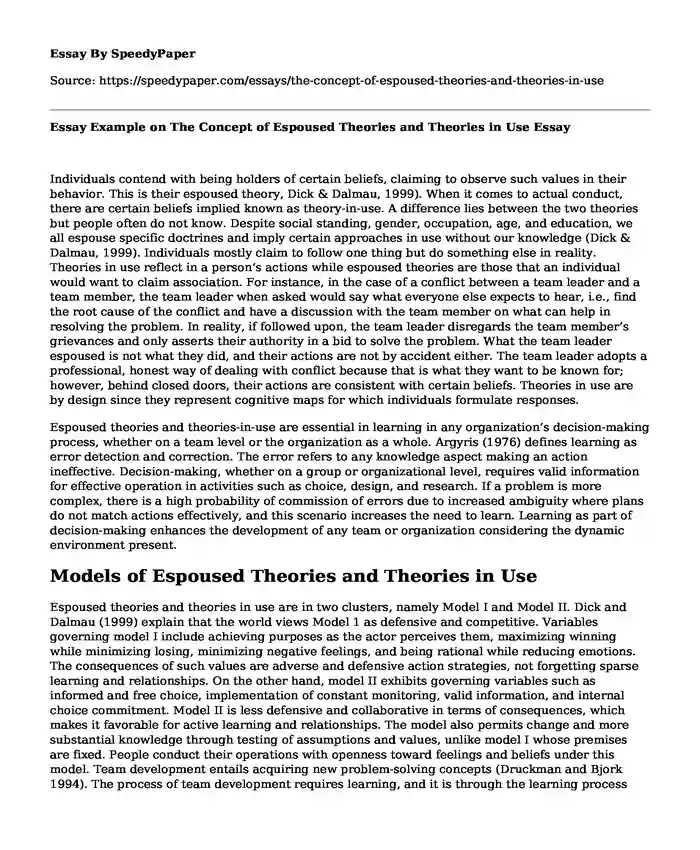
| Type of paper: | Essay |
| Categories: | Social psychology Human behavior Interpersonal communication |
| Pages: | 3 |
| Wordcount: | 672 words |
Individuals contend with being holders of certain beliefs, claiming to observe such values in their behavior. This is their espoused theory, Dick & Dalmau, 1999). When it comes to actual conduct, there are certain beliefs implied known as theory-in-use. A difference lies between the two theories but people often do not know. Despite social standing, gender, occupation, age, and education, we all espouse specific doctrines and imply certain approaches in use without our knowledge (Dick & Dalmau, 1999). Individuals mostly claim to follow one thing but do something else in reality. Theories in use reflect in a person’s actions while espoused theories are those that an individual would want to claim association. For instance, in the case of a conflict between a team leader and a team member, the team leader when asked would say what everyone else expects to hear, i.e., find the root cause of the conflict and have a discussion with the team member on what can help in resolving the problem. In reality, if followed upon, the team leader disregards the team member’s grievances and only asserts their authority in a bid to solve the problem. What the team leader espoused is not what they did, and their actions are not by accident either. The team leader adopts a professional, honest way of dealing with conflict because that is what they want to be known for; however, behind closed doors, their actions are consistent with certain beliefs. Theories in use are by design since they represent cognitive maps for which individuals formulate responses.
Espoused theories and theories-in-use are essential in learning in any organization’s decision-making process, whether on a team level or the organization as a whole. Argyris (1976) defines learning as error detection and correction. The error refers to any knowledge aspect making an action ineffective. Decision-making, whether on a group or organizational level, requires valid information for effective operation in activities such as choice, design, and research. If a problem is more complex, there is a high probability of commission of errors due to increased ambiguity where plans do not match actions effectively, and this scenario increases the need to learn. Learning as part of decision-making enhances the development of any team or organization considering the dynamic environment present.
Models of Espoused Theories and Theories in Use
Espoused theories and theories in use are in two clusters, namely Model I and Model II. Dick and Dalmau (1999) explain that the world views Model 1 as defensive and competitive. Variables governing model I include achieving purposes as the actor perceives them, maximizing winning while minimizing losing, minimizing negative feelings, and being rational while reducing emotions. The consequences of such values are adverse and defensive action strategies, not forgetting sparse learning and relationships. On the other hand, model II exhibits governing variables such as informed and free choice, implementation of constant monitoring, valid information, and internal choice commitment. Model II is less defensive and collaborative in terms of consequences, which makes it favorable for active learning and relationships. The model also permits change and more substantial knowledge through testing of assumptions and values, unlike model I whose premises are fixed. People conduct their operations with openness toward feelings and beliefs under this model. Team development entails acquiring new problem-solving concepts (Druckman and Bjork 1994). The process of team development requires learning, and it is through the learning process that espoused and theories in use are classified into a model I and II. Model 1 is suitable for the existence of a team; however, for the growth, and development of that team in terms of performance, model II is appropriate considering there is honesty involved.
References
Argyris, C. (1976), “Single-loop and double-loop models in research on decision making,” (Administrative Science Quarterly), Vol. 21, No. 3 pp. 363-375, doi: 10.2307/239184
Dick, B. & Dalmau, T. (1999). Values in action: When the good intentions of leaders are not enough. Available at: <http://www.dalmau.com/wp-content/uploads/2014/11/Values-in-Action.pdf> [Accessed May. 17, 2020]
Druckman, D. & Bjork, A.R. (1994). Learning, Remembering, Believing: Enhancing Human Performance. Washington, DC. National Academy Press.
Cite this page
Essay Example on The Concept of Espoused Theories and Theories in Use. (2023, Aug 10). Retrieved from https://speedypaper.com/essays/the-concept-of-espoused-theories-and-theories-in-use
Request Removal
If you are the original author of this essay and no longer wish to have it published on the SpeedyPaper website, please click below to request its removal:
- Paper Example - Learning and Motivation
- Essay Sample on Organic Solidarity and Gesellschaft Social Structure
- Essay Sample on Brief Summary of the Role-playing
- The Top Five Theoretical Frameworks That Best Explain the Causes of Crime. Essay Example
- The Hunger for More. Free Essay Example
- Essay Sample on "How a Handful of Tech Companies Control Billions of Minds Every Day."
- Understanding Customer Relationships: Evolution of Research Based on the Gap Model (SERVQUAL) - Free Essay
Popular categories




